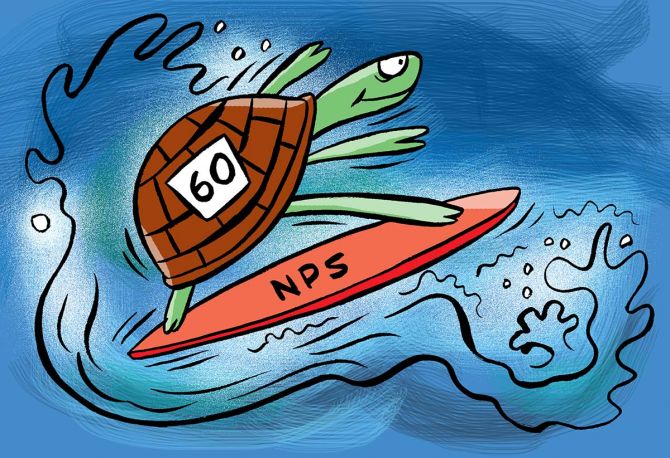But be ready for lock-in till the age of 60.
Sanjay Kumar Singh finds out more,

With interest income on provident fund contributions above Rs 2.5 lakh becoming taxable, many people are contemplating shifting the money they contributed to Voluntary Provident Fund (VPF) to the National Pension System (NPS).
They should understand the pros and cons of the two products before making a decision:
Risk and return
From April 1, the rate of return on Employees Provident Fund (EPF) will be 8.5 per cent on contributions till Rs 2.5 lakh.
Interest on contributions above Rs 2.5 lakh will be taxed at the slab rate.
For someone in the 30-per cent tax slab, the post-tax return on such contributions will be 5.85 per cent.
"EPF has zero credit risk since it is backed by the government. A post-tax rate of 5.8 per cent from a government-backed instrument remains attractive in the current scenario," says Deepesh Raghaw, founder, PersonalFinancePlan, a Securities and Exchange Board of India-registered investment advisor.
Among government-backed instruments, Public Provident Fund (PPF) offers 7.1 per cent tax-free.
"Many people contribute to EPF, but not to PPF. After the Budget, it should not happen that they invest more than Rs 2.5 lakh in EPF and VPF, but nothing to PPF. That would be a mistake," says Raghaw.
The risk in EPF is that it offers an above-market rate of return.
"If the EPF rate is linked to market rates, its return could come down in the future," says Arnav Pandya, founder, Moneyeduschool.
NPS is a market-linked instrument without guaranteed return.
It is a hybrid product with both an equity and a debt component.
"Investors can allocate to equities in NPS and can possibly earn a higher rate of return over the long term. But they must be prepared for volatility," says Arvind Rao, chartered accountant and founder, Arvind Rao & Associates.
Liquidity
Employees can make partial withdrawal from EPF in certain circumstances: in case of unemployment; to purchase or construct a house; to fund an illness, and so on.
You need to have been a member of EPF for a minimum number of years.
The amount that can be withdrawn also varies in each of these cases.
The rules for partial withdrawal from NPS are tighter.
You can withdraw only 25 per cent of your own contribution.
You can't withdraw either the employer's contribution, or the return earned on the deposits.
If you exit prematurely from NPS, then 80 per cent of the corpus must be annuitised.
Taxation
As mentioned, in EPF interest earned on contributions above Rs 2.5 lakh will be taxed.
"This will affect people who have a basic income of above Rs 1.74 lakh, or whose EPF+VPF contribution exceeds Rs 2.5 lakh," says Raghaw.
In NPS, the final corpus is taxed as follows: 40 per cent can be withdrawn lump-sum and is tax free.
Another 40 per cent must be annuitised.
Income from an annuity is taxed at the slab rate.
The balance 20 per cent can be withdrawn lump-sum, in which case it will be tax-free.
If it is annuitised, then income from the annuity will be taxed.
What should you do?
If you want assured, risk-free returns, then contribute Rs 2.5 lakh via the EPF/VPF route.
Then utilise the Rs 2.5 lakh limit on PPF.
Any amount above this contributed to VPF will earn a post-tax return of 5.8 per cent.
If you want higher returns, and are prepared for volatility, opt for NPS.
But be prepared for the lock-in till 60.
You must also be comfortable with compulsory annuitisation.
If you are not, then invest in NPS only up to Rs 50,000 to avail of the tax deduction.
Feature Presentation: Ashish Narsale/Rediff.com












 © 2025
© 2025